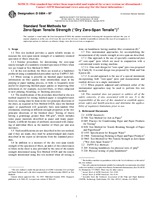Wir benötigen Ihre Einwilligung zur Verwendung der einzelnen Daten, damit Sie unter anderem Informationen zu Ihren Interessen einsehen können. Klicken Sie auf "OK", um Ihre Zustimmung zu erteilen.
ASTM D5804-97
Standard Test Methods for Zero-Span Tensile Strength (""Dry Zero-Span Tensile"")
Automatische name übersetzung:
Standard-Prüfverfahren für Zero-Span Zugfestigkeit ( "Dry Zero-Span Zugversuch " )
NORM herausgegeben am 10.12.1997
Informationen über die Norm:
Bezeichnung normen: ASTM D5804-97
Anmerkung: UNGÜLTIG
Ausgabedatum normen: 10.12.1997
SKU: NS-32628
Zahl der Seiten: 8
Gewicht ca.: 24 g (0.05 Pfund)
Land: Amerikanische technische Norm
Kategorie: Technische Normen ASTM
Die Annotation des Normtextes ASTM D5804-97 :
Keywords:
fibers, paper, paperboard, zero-span tensile
Ergänzende Informationen
| 1. Scope |
|
1.1 This test method provides a quick reliable means to measure the zero-span tensile strength of a randomly oriented specimen of fibers when dry. 1.1.1 Similar procedures for determining the zero-span tensile strength of a randomly oriented specimen of fibers when wet are found in Test Method D5803. 1.2 In this test method, the fibers are tested as a handsheet produced using a standardized procedure such as TAPPI T205. 1.3 While testing is possible on finished paper materials, information on fiber quality from intermediate steps in the pulping or paper making process, or both, is frequently more useful for improving finished paper quality or improving fiber utilization of, for example, recycled fibers, or fibers subjected to new pulping, bleaching, or finishing processes. 1.4 The modifications of the procedure described in this test method required for testing finished paper is straightforward; however, testing must be done in the two principle directions of the sheet, as required in Test Method D828, since the finished paper or paperboard will generally have non-random fiber orientation, resulting in different strength properties in the two principle directions of the finished sheet. Testing of sheets having a grammage greater than 100 g/m , which includes some paper materials described as paper and many paperboards, is difficult because of problems associated with clamping of individual fibers as the number of fibers per unit area increases. 1.5 Such modifications are not described in this test method, and if they are made, they shall be acknowledged and clearly described in the report as deviations from the standard procedure. 1.6 In addition to a measure of the dry zero-span tensile strength of the specimen of fibers, an index of the cohesiveness of fibers in the sheet is also provided by the ratio of the tensile strength determined using Test Method D828 and the tensile strength determined using this test method when all testing is done on handsheets having random fiber orientation (1). 1.7 Two instrumental approaches for accomplishing the measurement of dry tensile strength at zero-span are described. 1.7.1 One approach is the use of specially constructed pair of "zero-span" jaws which are used in conjunction with a conventional tensile testing machine. 1.7.1.1 One such design for "zero-span" jaws was proposed by Clark (1). A second design was proposed by Wink and Van Eperen (2). 1.7.2 A second approach is the use of a special instrument incorporating both "zero-span" jaws and measurement and readout devices in a single instrument. 1.7.3 When properly adjusted and calibrated, either of the instrumental approaches may be used to perform this test method. 1.8 This standard does not purport to address all of the safety concerns, if any, associated with its use. It is the responsibility of the user of this standard to establish appropriate safety and health practices and determine the applicability of regulatory limitations prior to use. |



 Cookies
Cookies
